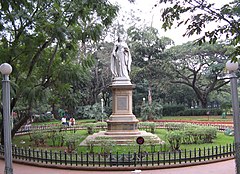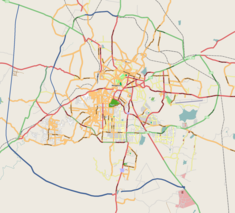
The Wadiyar dynasty,(Kannada:[ oɖejɐru]) also referred to as the Wadiyars of Mysore, is a late-medieval Indian royal family of former maharajas of Mysore from the Urs clan originally based in Mysore city.

Raj Bhavan is the official residence of the governor of Karnataka located in Bengaluru city, in the State of Karnataka, India. Constructed in the late 19th century.

Lalbagh Botanical Garden or simply Lalbagh, is a botanical garden in Bangalore, India, with an over 200-year history. First planned and laid out during the dalavaiship of King Hyder Ali, the garden was later managed under numerous British Superintendents before Indian Independence. It was responsible for the introduction and propagation of numerous ornamental plants as well as those of economic value. It also served a social function as a park and recreational space, with a central glass house dating from 1890 which was used for flower shows. In modern times, it hosts two flower shows coinciding with the week of Republic Day and Independence Day. As an urban green space along with Cubbon Park, it is also home to numerous wild species of birds and other wildlife. The garden also has a lake adjoining a large rock on which a watchtower had been constructed during the reign of Kempegowda II.

Mysore district, officially Mysuru district, is an administrative district located in the southern part of the state of Karnataka, India. It is the administrative headquarters of Mysore division. Chamarajanagar District was carved out of the original larger Mysore District in the year 1998. The district is bounded by Chamrajanagar district to the southeast, Mandya district to the east and northeast, Kerala state to the south, Kodagu district to the west, and Hassan district to the north.
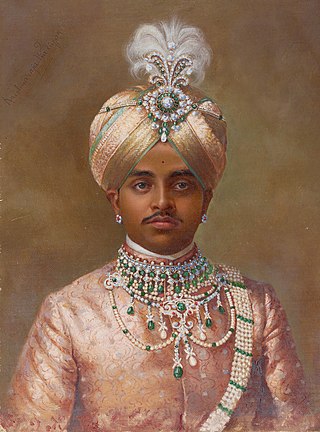
Krishnaraja Wadiyar IV (4 June 1884 – 3 August 1940) was the twenty-fourth Maharaja of Mysore, reigning from 1902 until his death in 1940.
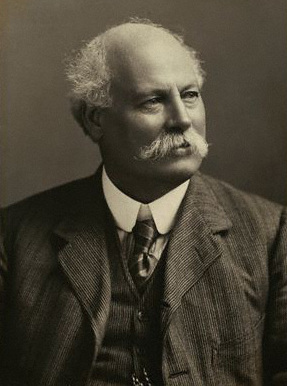
Sir Thomas Brock was an English sculptor and medallist, notable for the creation of several large public sculptures and monuments in Britain and abroad in the late nineteenth and early twentieth centuries. His most famous work is the Victoria Memorial in front of Buckingham Palace, London. Other commissions included the redesign of the effigy of Queen Victoria on British coinage, the massive bronze equestrian statue of Edward, the Black Prince, in City Square, Leeds and the completion of the statue of Prince Albert on the Albert Memorial.

Bengaluru is the capital city of the state of Karnataka. Bengaluru, as a city, was founded by Kempe Gowda I, who built a mud fort at the site in 1537. But the earliest evidence for the existence of a place called Bengaluru dates back to c. 890.
The Bangalore Cantonment (1806–1881) was a military cantonment of the British Raj based in the Indian city of Bangalore. The cantonment covered an area of 13 square miles (34 km2), extending from the Residency on the west to Binnamangala on the east and from the Tanneries on Tannery Road in the north to AGRAM in the south. By area, it was the largest British military cantonment in South India. The British garrison stationed in the cantonment included three artillery batteries, and regiments of the cavalry, infantry, sappers, miners, mounted infantry, supply and transport corps and the Bangalore Rifle Volunteers. The Bangalore Cantonment was directly under the administration of the British Raj, while Bangalore City itself was under the jurisdiction of the Durbar of the Kingdom of Mysore.
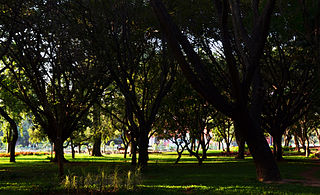
Cubbon Park, officially Sri Chamarajendra Park, is a landmark park in Bengaluru, located in the heart of the city in the Central Administrative Area. Originally created in 1870 under Major General Richard Sankey, then British Chief Engineer of Mysore State, it covered an area of 100 acres (0.40 km2). Subsequent expansion has since taken place and the park's area is now reported to be 300 acres (1.2 km2). It has a rich recorded history of abundant flora and fauna plantations coupled with numerous impressive and aesthetically located buildings and statues of famous personages, in its precincts.

Colonel Mark Wilks was a Madras Army officer, historian and colonial administrator who worked in southern India principally in the princely state of Mysore. He was the acting Resident at the Wodeyar Court.

Lieutenant-General Sir Mark Cubbon KCB was a British army officer with the East India Company who was the Chief Commissioner of Mysore 1834 to 1861. During his tenure, he established a law and order system, introduced judicial and economic reforms and through action in all spheres of governance helped develop the economy of Mysore. He resigned from his office in 1860 due to ill-health and left for England for the first time since his arrival in India as a cadet in 1800. The administration of the Kingdom of Mysore under his leadership ensured that the 1857 rebellion had almost no impact in the region. He died in 1861 on board ship at Suez. Cubbon Road and Cubbon Park in Bangalore are named after him.
The Mysore Commission, also known as Commissioners' Rule or simply the Commission Rule, was a period and form of government in the history of the Kingdom of Mysore and the neighbouring province of Coorg from 1831 to 1881 when British commissioners administered the kingdom due to the deposition of Maharaja Krishnaraja Wodeyar III and later during the minority of Yuvaraja Chamaraja Wadiyar X. A board of commissioners constituted the chief executive body and provincial head of the kingdom's government. The commission began with uninstallation of Krishnaraja Wodeyar III as King in 1831 and ended with investing Chamaraja Wadiyar X as the new maharaja in 1881.
There are nearly a thousand inscriptions in Tamil in the Southern Karnataka districts of Bangalore, Mysore, Kolar and Mandya in India. Nearly one third of these inscriptions are found in the Kolar District. Of all the inscriptions collected and published in the Epigraphia Carnatica Vol X for Kolar district, a fourth are in Tamil. The Tamil inscriptions start to appear around 1000 AD, after the conquest of the region by the Chola dynasty king Rajaraja I. Even after the Cholas left the area, the Hoysala and later the Vijaynagar kingdoms continued to use Tamil in the inscriptions.
St. Andrew's Church, consecrated in 1866, is a Presbyterian church, located on Cubbon Road, Bangalore. Initially knows as St. Andrews's Kirk, it was a Church of Scotland church till 1959 when it became part of the Karnataka Central Diocese of the Church of South India. The church is named after Saint Andrew, the patron saint of Scotland. St Andrew's Church celebrated its 150 years anniversary on 20 November 2014.

St. Bartholomew's Church is an Anglican church, built by the Madras Government for the East India Company troops stationed in Kingdom of Mysore and is located in Lashkar Mohalla, on the Nilgiri Road, near the noisy Mysore sub-urban bus stand in Mysore City. The church grounds was consecrated on 29 November 1830 by Bishop Turner of Calcutta, (p. 327) and the building was completed in 1832. The church is named after Saint Bartholomew, one of the 12 apostles of Jesus Christ, and is said to have visited India in the first century AD, and preached the Christian gospel in the Kalyan, Thane and Raigad regions of present-day Maharashtra.

The Fort Church, Bangalore, was a church located within Bangalore Fort. The church was demolished to make place for the construction of the Vani Vilas Hospital. The Government of Mysore then allotted land in Chamrajpet for construction of a new church, St. Luke's Church, Bangalore. Early records refer to the Fort Church as the Drummer's Chapel, constructed by British soldiers after the fall of Tippu Sultan. The Fort Church, Bangalore was the first protestant church to be raised in Bangalore.
The Rice Memorial Church is located in the busy Avenue Road, Bangalore Pete. It is named after Rev. Benjamin Holt Rice, a missionary of the London Missionary Society (LMS), a Canarese scholar and a pioneer of education in the Bangalore Pete region. The Rice Memorial Church stands on a busy street in the midst of temple, dargahs, book shops and heavy traffic, with its colonial British structure appearing to be out of place in the traditional Bangalore market district. The church stands on the site of the London Mission Canarese Chapel built by Rev. Rice, which itself was built on the site of the first Canarese chapel built by William Campbell in 1834. The church is a stone building in the European Classical style, with Tuscan columns, pediments and keystone arch windows. The church building has been demolished and raised at least 3 times, with the current structure consecrated in 1917.

The statue of Edward VII in Bangalore is located at Queen's Park, next to Cubbon Park, Bangalore Cantonment, at the junction of Queen's Road and Cubbon Road. The statue was unveiled in November 1919 by the then Viceroy and Governor-General of India, Frederic John Napier, Baron Chelmsford. The statue was raised out of funds raised by the residents of the Bangalore Civil and Military Station. The Statue of King Edward VII is one of the few of the original statues which were installed in British India, to still stand at its original location. The statue rises above a flowering frangipani tree. On the other end of Queen's Park is the Statue of Queen Victoria, Bangalore. The statue was designed and sculpted by Leonard Jennings of Chelsea, London.
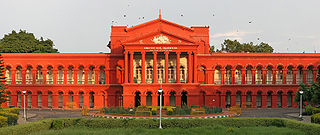
Attara Kacheri in Bangalore, India, is the seat of the principal bench of the Karnataka High Court, the highest judicial authority in the state of Karnataka. It is a neoclassical red-painted stone and brick building in Cubbon Park, located on Dr. B. R. Ambedkar Road opposite the Vidhana Soudha. It previously housed the secretariat of the princely state of Mysore and then that of independent India's Mysore State.
Agha Aly Asker was a Persian horse trader and landowner who emigrated to Bangalore, in India, in 1824 from Shiraz, Iran. He is considered the founding father of the Persian diaspora in the city whose legacy still lives on through the various colonial buildings he constructed at the behest of the Commissioner of Mysore Sir Mark Cubbon. Aly Asker was responsible for constructing the Governor's residence, the State Guesthouse- Balabrooie, Leela Nivas off Cunningham Crescent, among many others. He is also credited with putting Bangalore on the horse-racing map.




